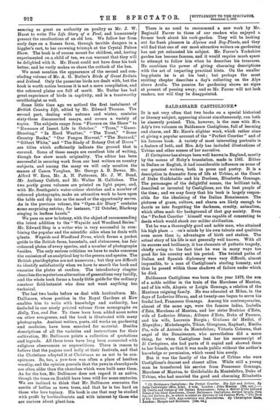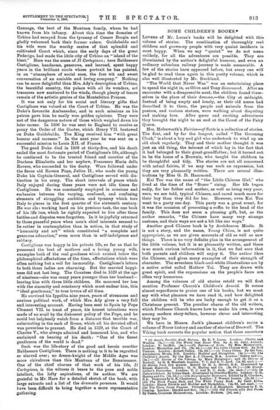BALDASSARE CASTIGLIONE.* IT is not very often that two books
on a special historical or literary subject, appearing almost simultaneously, can both be sincerely praised. This, however, is the case with Mrs. Ady's two volumes on Baldassare Castiglione, full of learning and charm, and Mr. Hare's slighter work, which rather aims at giving a popular account of the "Perfect Courtier" and of his famous book. A variety of most interesting portraits is a feature of both, and Mrs. Ady has included illustrations of Urbino and other scenes of her narrative.
It Cortegiano has always been well known in England, mostly by the means of Hoby's translation, made in 1561. Either in Italian or English, it bacrconsiderable influence on some of our greatest writers, both in prose and poetry. It is a description in dramatic form of life at Urbino, at the Court of Duke Guidobaldo and his Duchess, Elisabetta Gonzaga. The personages of the delightful scenes, the brilliant talk, described or invented by Castiglione, are the best people of the time ; and we may fancy that his book is largely respon- sible for the idealising of the Italian Renaissance. The pictures of grace, culture, and charm are likely enough to dazzle us into forgetting the darkness, cruelty, animalism, which often made the background of that gay society. Even the "Perfect Courtier ' himself was capable of consenting to deeds which would shock our milder civilisation.
Yet he was a thoroughly good and noble man, who attained his high place ..i .en's minds by his own talents and qualities even more than bj advantages of birth and station. The actual story of his life is not generally well known. With all its success and brilliancy, it has elements of pathetic tragedy, chiefly owing to the fact that be was in many ways too good for his country and his period. The twisted paths of Italian and Spanish diplomacy were very difficult, almost impossible, to a man of Castiglione's sterling honesty, and thus he passed within those shadows of failure under which he died.
.Baldassare Castiglione was born in the year 1478, the eon of a noble soldier in the train of the Marchese of Mantua, and of his wife, Aloysia or Luigia Gonzaga, a relation of the Mantuan reigning family. He was educated at Milan, in the days of Lodovico Sforza, and at twenty-one began to serve his feudal lord, Francesco Gonzaga. Among his contemporaries, almost of the same age, were the famous ladies, Isabella d'Este, Marchesa of Mantua, and her sister Beatrice d'Este, wife of Lodovico Sforza ; Alfonso d'Este, Duke of Ferrara, and his wife, Lucrezia Borgia ; Giuliano de' Medici, il Magnifico ; Michelangelo, Titian, Giorgione, Raphael ; Eniilia Pia, wife of Antonio da Montefeltro; Vittoria Colonna, that angel of the Renaissance, who nevertheless did a mean thing, for when Castiglione lent her his manuscript of II Cartegiano, she had parts of it copied and showed them to her friends, so that it was made public without the author's knowledge or permission, which vexed him sorely.
But it was the family of the Duke of Urbino who were Castiglione's dearest and closest allies. While still a young man he transferred his service from Francesco Gonzaga, Marchese of Mantua, to G-uidobaldo da Montefeltro, Duke of Urbino, who had married the good and charming Elisabetta
• (1) Baldassare Castiglione: the Perfect Courtier. His Life and Letters. By Julia Cartwright (Mrs. Ady). 8 vols. London : John Murray. [30s. net.,)— (2) Courts and Camps of the Italian Renaissance: being a Mirror of the Life and Times of the Ideal Gentleman, Count Baldassare Castiglione, derived largely front his own Letters, Ac., to which is added an Epitome of his Famous Work, " The Book of the Courtier," with Appreciations and Annotations. By Christopher Rime. London: Harper and Brothers. [10s. 63.1 Gonzaga, the best of the Mantuan family, whom he had known from his infancy. About this time the domains of Urbino had escaped from the tyranny of Cesare Borgia and gladly welcomed back their former rulers. Guidobaldo and his wife were the worthy centre of that splendid and cultivated Court which, since the early days of the great Feder*, had made the little city of Urbino an "island of the blest." Here was the scene of II Cortegiano ; here Baldassare Castiglione, handsome, generous, and learned, spent happy years in the brilliant circle whose portrait he has painted, in an "atmosphere of social ease, the free wit and sweet conversation of an amiable and loving company." Nothing can be more delightful than Mrs. Ady's description of Urbino, the beautiful country, the palace with all its wonders, art treasures now scattered to the winds, though plenty of traces remain of the artistic genius of the Montefeltro Princes.
It was not only for his social and literary gifts that Castiglione was valued at the Court of Urbino. He was the Duke's favourite Ambassador, and in such missions as his patron gave him he easily won golden opinions. They were not of the dangerous nature of those which weighed down his later career. In 1506 he was sent to England to receive as proxy the Order of the Garter, which Henry VII. bestowed on Duke Guidobaldo. The King received him "with great honour and caresses." In the next year he was sent on a successful mission to Louis XII. of France.
The good Duke died in 1508 at thirty-five, and his death ended the most fortunate period of Castiglione's life, although be continued to be the trusted friend and courtier of the Duchess Elisabetta and her nephew, Francesco Maria della Rovere, who succeeded to the duchy. Wars followed under the fierce old Rovere Pope, Julius II., who made the young Duke his Captain-General, and Castiglione served with dis- tinction in his army. The short intervals of peace which Italy enjoyed during these years were not idle times for Castiglione. He was constantly employed in missions and embassies between the varying, confused, and confusing elements of struggling ambition and tyranny which tore Italy to pieces in the first quarter of the sixteenth century. He was als ) working hard on his precious task, the one book of his life hue, which he rightly expected to live after these battles and disputes were forgotten. In it he joyfully returned to those peaceful years when men's chief interests seemed to lie rather in contemplation than in action, in that study of "humanity and art" which constituted "a complete and generous education," even more than in self-indulgence and robbery.
Castiglione was happy in his private life, so far as that he possessed the best of mothers and a loving young wife, examples both of the real goodness which existed below the philosophical affectations of the time, affectations which were often nothing but a veil for immorality. Castiglione's letters to both these ladies are charming. But the married happi- ness did not last long. The Countess died in 1520 at the age of nineteen—she was many years younger than her husband— leaving him with three little children. He mourned her loss with the sincerity and constancy which must endear him, this "ideal gentleman," to true lovers of all time.
He survived his Ippolita nine years, years of strenuous and anxious political work, of which Mrs. Ady gives a very full and interesting account. Having been sent to Spain by Pope Clement VII. to treat of peace, his honest intentions were made of no avail by the dishonest policy of the Pope, and he could but helplessly watch from a distance that terrible war, culminating in the sack of Rome, which all his devoted effort was powerless to prevent. He died in 1529, at the Court of Charles V., who always admired and honoured him, and who exclaimed on hearing of his death: "One of the finest gentlemen of the world is dead."
Such was the life-story of the good and heroic courtier Baldassare Castiglione. There is nothing in it to be regretted or slurred over; no dream-knight of the Middle Ages was more chivalrous than this Mantuan of the Renaissance. One of the chief charms of that work of his life, It Cortegiano, is the witness it bears to the pure and noble intellect, the lofty aspirations, of its author. We are grateful to Mr. Hare for a detailed sketch of the book, with large extracts and a list of the dramatis personae. It would have been difficult to bring together a more representative gathering.







































































 Previous page
Previous page